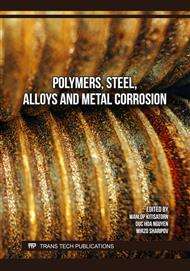[1]
M. A. dos Santos and A. Grenha, "Polysaccharide Nanoparticles for Protein and Peptide Delivery," 2015, p.223–261.
DOI: 10.1016/bs.apcsb.2014.11.003
Google Scholar
[2]
V. Krstonošić, J. Jovičić-Bata, N. Maravić, I. Nikolić, and L. Dokić, "Rheology, structure, and sensory perception of hydrocolloids," in Food Structure and Functionality, Elsevier, 2021, p.23–47.
DOI: 10.1016/B978-0-12-821453-4.00005-3
Google Scholar
[3]
C. Rochas and M. Rinaudo, "Mechanism of gel formation in κ‐carrageenan," Biopolymers, vol. 23, no. 4, p.735–745, Apr. 1984.
DOI: 10.1002/bip.360230412
Google Scholar
[4]
Z. Liu, X. Ren, Y. Cheng, G. Zhao, and Y. Zhou, "Gelation mechanism of alkali induced heat-set konjac glucomannan gel," Trends Food Sci Technol, vol. 116, p.244–254, Oct. 2021.
DOI: 10.1016/j.tifs.2021.07.025
Google Scholar
[5]
Y. Wang, J. Liu, Q. Li, Y. Wang, and C. Wang, "Two natural glucomannan polymers, from Konjac and Bletilla, as bioactive materials for pharmaceutical applications," Biotechnol Lett, vol. 37, no. 1, p.1–8, Jan. 2015.
DOI: 10.1007/s10529-014-1647-6
Google Scholar
[6]
Y. Sun et al., "Review of Konjac Glucomannan Structure, Properties, Gelation Mechanism, and Application in Medical Biology," Polymers (Basel), vol. 15, no. 8, p.1852, Apr. 2023.
DOI: 10.3390/polym15081852
Google Scholar
[7]
K. S. Kang, G. T. Veeder, P. J. Mirrasoul, T. Kaneko, and I. W. Cottrell, "Agar-Like Polysaccharide Produced by a Pseudomonas Species: Production and Basic Properties," Appl Environ Microbiol, vol. 43, no. 5, p.1086–1091, May 1982.
DOI: 10.1128/aem.43.5.1086-1091.1982
Google Scholar
[8]
R. Y. Lochhead, "The Use of Polymers in Cosmetic Products," in Cosmetic Science and Technology, Elsevier, 2017, p.171–221.
DOI: 10.1016/B978-0-12-802005-0.00013-6
Google Scholar
[9]
S. W. Cui, Y. Wu, and H. Ding, "The range of dietary fibre ingredients and a comparison of their technical functionality," in Fibre-Rich and Wholegrain Foods, Elsevier, 2013, p.96–119.
DOI: 10.1533/9780857095787.1.96
Google Scholar
[10]
B. Cui et al., "A novel κ-carrageenan/konjac gum thermo-irreversible gel improved by gellan gum and Ca2+," LWT, vol. 154, p.112645, Jan. 2022.
DOI: 10.1016/j.lwt.2021.112645
Google Scholar
[11]
R. Sothornvit and J. M. Krochta, "Plasticizers in edible films and coatings," in Innovations in Food Packaging, Elsevier, 2005, p.403–433.
DOI: 10.1016/B978-012311632-1/50055-3
Google Scholar
[12]
F. Fahrullah, L. E. Radiati, P. Purwadi, and D. Rosyidi, "The Effect of Different Plasticizers on the Characteristics of Whey Composite Edible Film," Jurnal Ilmu dan Teknologi Hasil Ternak, vol. 15, no. 1, p.31–37, Mar. 2020.
DOI: 10.21776/ub.jitek.2020.015.01.4
Google Scholar
[13]
"IPC-TM-650 TEST METHODS MANUAL," The Institute for Interconnecting and Packaging Electronic Circuits. Accessed: Jul. 02, 2024. [Online]. Available: https://www.ipc.org/sites/default/files/test_methods_docs/2.4.18.3.pdf
Google Scholar
[14]
A. Gennadios, A. Handa, G. W. Froning, C. L. Weller, and M. A. Hanna, "Physical Properties of Egg White−Dialdehyde Starch Films," J Agric Food Chem, vol. 46, no. 4, p.1297–1302, Apr. 1998.
DOI: 10.1021/jf9708047
Google Scholar
[15]
"Standard Test Methods for Water Vapor Transmission of Materials," ASTM International.
DOI: 10.1520/E0096_E0096M-05
Google Scholar
[16]
E. K. Tunieva, K. I. Spiridonov, and V. V Nasonova, "A study on the synergetic interaction of kappa-carrageenan with konjac gum," IOP Conf Ser Earth Environ Sci, vol. 640, no. 5, p.052012, Feb. 2021.
DOI: 10.1088/1755-1315/640/5/052012
Google Scholar
[17]
Arham, "Physical and mechanical properties of agar based edible film with glycerol plasticizer," International Food Research Journal , Dec. 2015, Accessed: Jul. 09, 2024. [Online]. Available: http://www.ifrj.upm.edu.my/23%20(04)%202016/(42).pdf
Google Scholar
[18]
J. Kozlowska, K. Pauter, and A. Sionkowska, "Carrageenan-based hydrogels: Effect of sorbitol and glycerin on the stability, swelling and mechanical properties," Polym Test, vol. 67, p.7–11, May 2018.
DOI: 10.1016/j.polymertesting.2018.02.016
Google Scholar
[19]
L. H. Cheng, A. A. Karim, and C. C. Seow, "Effects of Water‐Glycerol and Water‐Sorbitol Interactions on the Physical Properties of Konjac Glucomannan Films," J Food Sci, vol. 71, no. 2, Mar. 2006.
DOI: 10.1111/j.1365-2621.2006.tb08898.x
Google Scholar
[20]
N. A. Ismail, K. A. M. Amin, and M. H. Razali, "Preparation of Gellan Gum (GG) Film: The effect of GG, Calcium Chloride (CaCl 2 ), Glycerol Concentration and Heat Treatment," IOP Conf Ser Mater Sci Eng, vol. 440, p.012006, Oct. 2018.
DOI: 10.1088/1757-899X/440/1/012006
Google Scholar
[21]
Z. Eslami, S. Elkoun, M. Robert, and K. Adjallé, "A Review of the Effect of Plasticizers on the Physical and Mechanical Properties of Alginate-Based Films," Molecules, vol. 28, no. 18, p.6637, Sep. 2023.
DOI: 10.3390/molecules28186637
Google Scholar
[22]
H. W. Tan, A. R. Abdul Aziz, and M. K. Aroua, "Glycerol production and its applications as a raw material: A review," Renewable and Sustainable Energy Reviews, vol. 27, p.118–127, Nov. 2013.
DOI: 10.1016/j.rser.2013.06.035
Google Scholar
[23]
T. P. Singh, M. K. Chatli, and J. Sahoo, "Development of chitosan based edible films: process optimization using response surface methodology," J Food Sci Technol, vol. 52, no. 5, p.2530–2543, May 2015.
DOI: 10.1007/s13197-014-1318-6
Google Scholar



